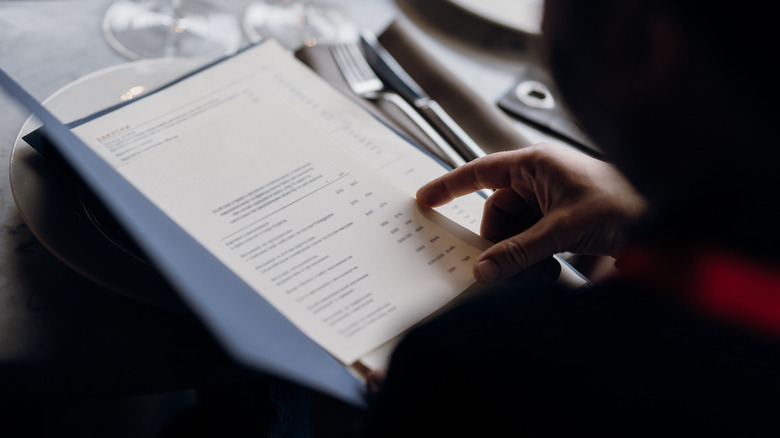The First Ever Menu In History Was Carved On A Stone Tablet
Let's take a journey back in time. The first modern restaurant, where the public could choose their food from a whole list of options, sprang up in Paris circa 1765, per Encyclopedia Britannica. Fittingly, the sign identifying the establishment read "restaurants," referencing restorative soups and broths in French; that's where the word "restaurant" as we use it today originally comes from. Although a food service pioneer, this commercial dining room was still predated by several more ancient examples.
Two unrelated Eastern traditions were also instrumental in restaurant history. During the 1500s, Japanese teahouses begot a culture where folks could enjoy multicourse meals with specialty utensils and tableware (via HISTORY). These experiences also included tasting menus that reflected the identity of different times and locations. Elsewhere, in 12th-century China, the northern and southern capitals of the Song Dynasty had complementary restaurants where visitors could find a taste of home rather than try the local fare. Options abounded, from chop suey to dim sum to noodles. At the fanciest of these spots, myriad pre-plated items were shown off to patrons, and waiters took their orders before relaying such requests to the kitchen via song.
Even before that, stretching thousands of years into the past, street vendors and roadside inns offered customers meals for purchase. However, consumers rarely if ever had a say in what specifically was served. Even so, we need not look at restaurants particularly to find the first menu in history. After all, menus can also be found at banquets.
Assyrian feasts
The concept of dining in formal settings goes back to the earliest civilizations. This includes Mesopotamia and its Assyrian Empire, according to the American Society of Overseas Research. The Assyrian Empire, as explained by National Geographic, was a conglomerate of city-states located in what is now the northern Middle East. Although ancient Assyria had been around since the second millennium B.C., it was in the first millennium B.C. that it reached its zenith, conquering others with Iron Age weapons and technology.
When Assyria wasn't going to war, it was often celebrating its victories with food. This tradition of sharing meals — especially among royals — played an important role in the politics and social customs of the empire. Kings used feasts to display their wealth and power, asserting dominance over others. Food was also frequently distributed to loyal servants, given as a tribute to nobles, or even offered to the gods. Such meals were often strikingly bold, mixing together sweet and salty ingredients such as sugar and garlic with little regard for separating flavor categories. Seasonings were abundant, too, and people had a taste for the strong stuff like fermented, sour, and toasted dishes. It was this culinary tradition that produced the earliest recorded menu.
The Banquet Stele
The first ever menu we know of was carved into a stone tablet — also known as a stele when positioned upright and adorned with inscriptions. World History Encyclopedia recounts how Ashurnasirpal II rose to power in the Assyrian Empire circa 884 B.C., putting down rebellions and fortifying his realm's expanding borders. All this conquering enriched the King's pockets, and thus, Ashurnasirpal II was able to restore a ruined city and make it his capital, complete with a brand-new grand palace.
In order to celebrate this achievement, Ashurnasirpal II threw a party of sorts. The Open Richly Annotated Cuneiform Corpus documents how the King's celebration lasted for 10 whole days. Nearly 70,000 attendees were invited, including thousands of foreign VIPs. There, they enjoyed hundreds of breads, cheeses, fruits, grains, nuts, and veggies flavored with honey and spices. They also had thousands of deer, sheep, and oxen, as well as tens of thousands of birds, eggs, and fish. Nearly 10,000 jugs of beer and the same number of wineskins were provided as refreshments. This extensive menu was etched into what is now known as the Banquet Stele, which was displayed in Ashurnasirpal II's throne room.
Notably, Ashurnasirpal II made sure that nobody would forget this menu was his. Multiple lines on the stele introduce the king and list his many accomplishments before describing any of the food. Eventually, the Assyrian Empire fell, but the Banquet Stele yet endured, serving as a relic of a time-honored culinary tradition.


